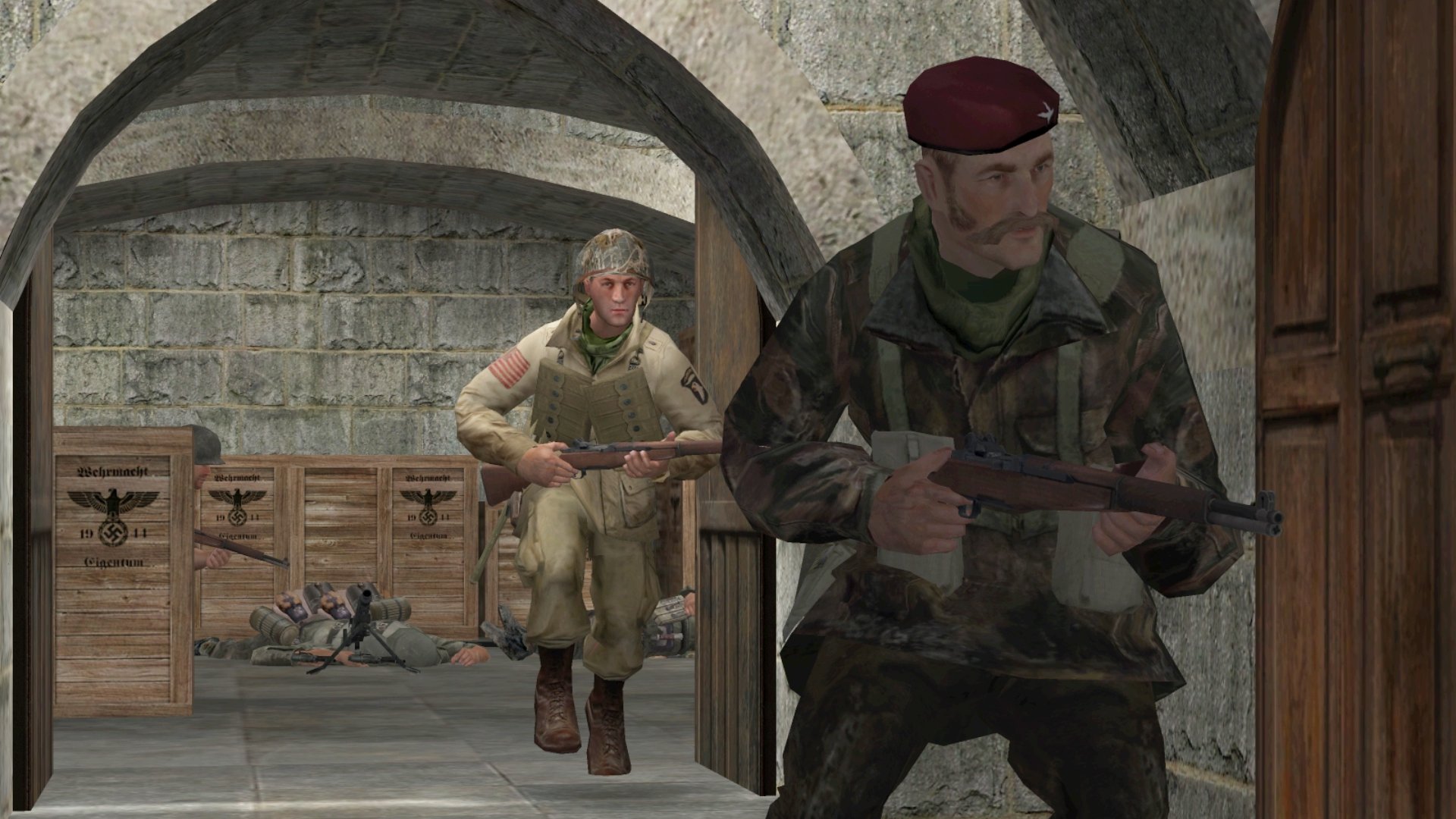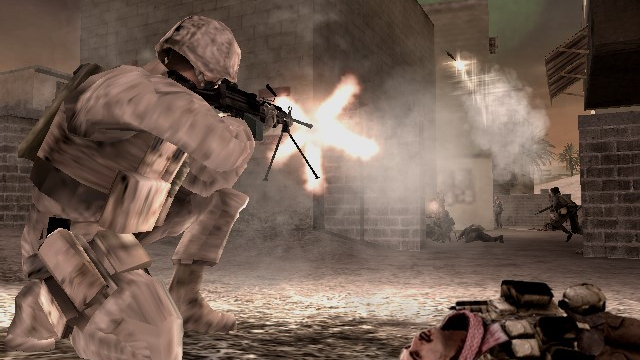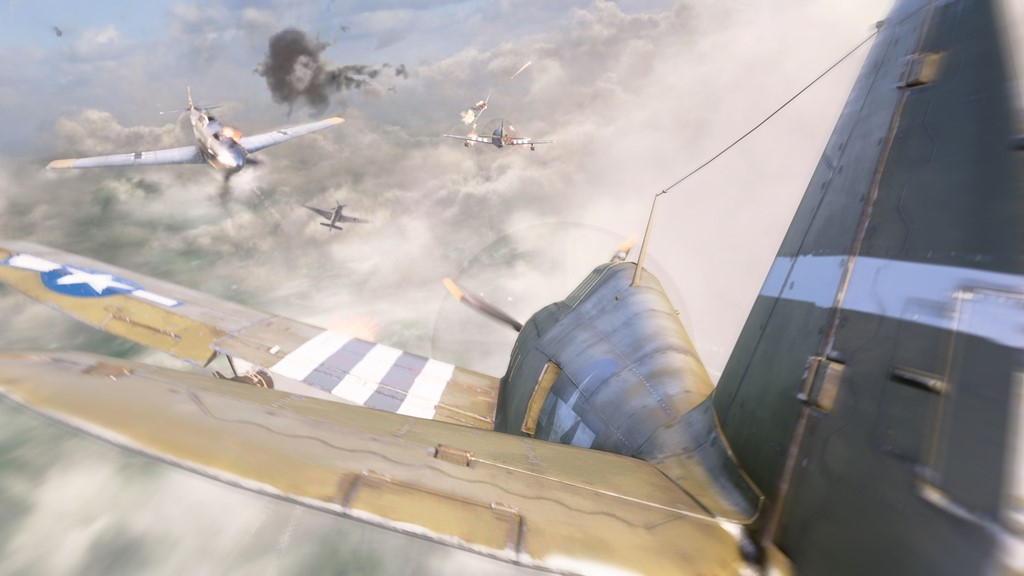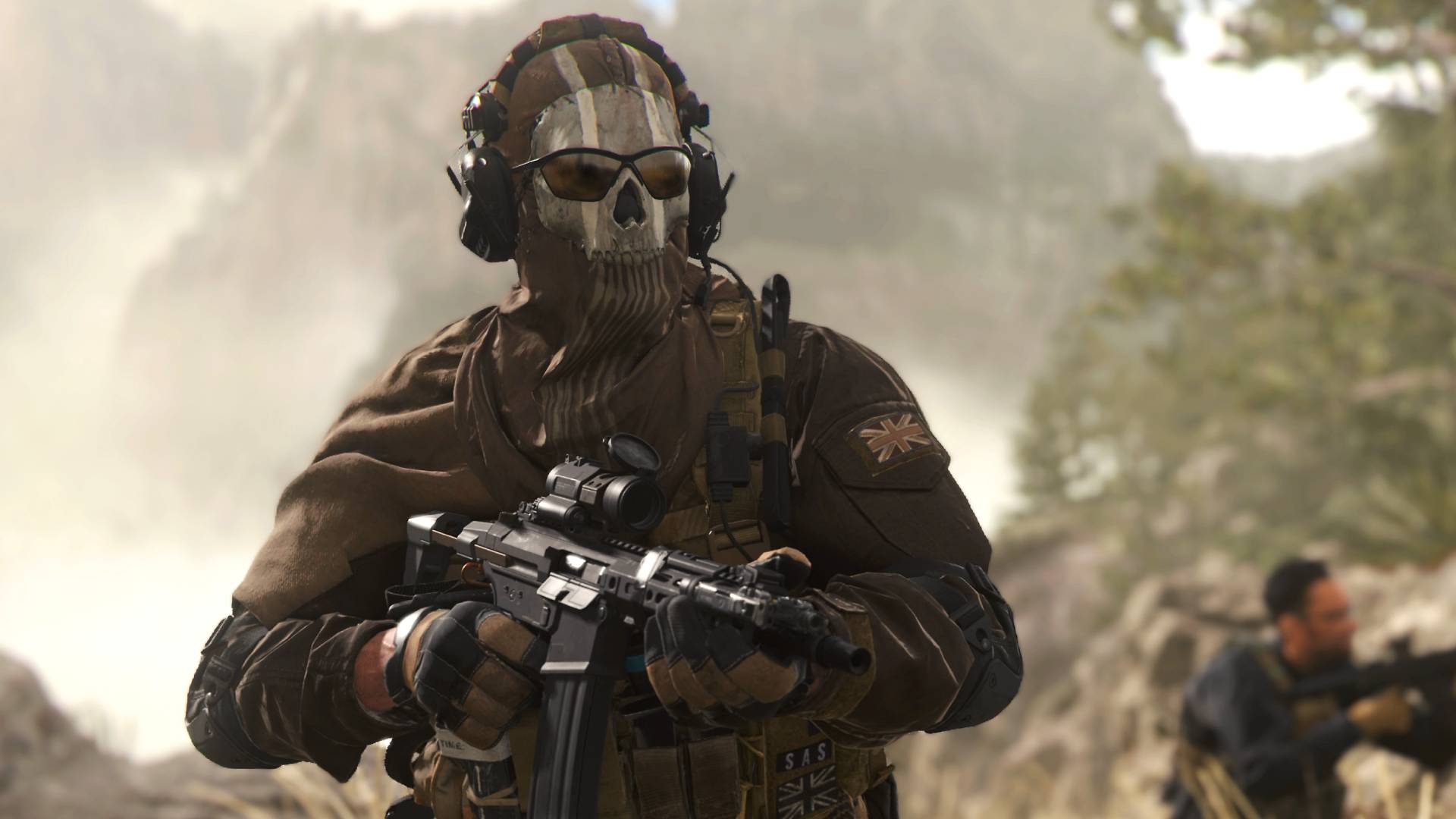
Hopes weren’t especially high. The year was 2003, we were already multiple Medals of Honor deep, and Return to Castle Wolfenstein was still installed on our HDDs. Former Dreamworks Interactive devs had founded a new outfit called Infinity Ward, we read in games mags at the time, and they were working on another World War 2 shooter. Snore. What’s for dinner? Bolognese, you say?
And then it came out, six hours of cacophonous gunfire, heroic shouting, and immaculate set-pieces that immersed you in the war as you’d never been before. Call of Duty was a genuine shock to the system.
Previous WW2 shooters had treated the conflict as a visual theme and a source of historical weaponry, but, aside from Medal of Honor’s beach landing, they hadn’t made much effort to recreate the engagements that actually formed the war. They were goose-stepping corridor shooters in which the player, by necessity, wins the war all on their own while the rest of the allied force puts its feet up and reads about your improbable deeds in the papers.
Call of Duty was different. It seemed cine-literate in a way that games just weren’t at the time. It knew how much more emotive it was to be placed in a gunfight next to squadmates than to sweep the trenches clear of Nazi litter single-handedly. It had a fresh narrative approach in that way, and the technical chops to back it up.

You spend your first few missions as a US marine in occupied France under almost constant gunfire. If you stand still for long enough and take in your surroundings, you realize almost all of it is simply ambient noise without a source – there aren’t legions of German troops gunning for you, but just a handful of carefully placed enemies that give a very effective impression of a bigger and more intense conflict.
But you don’t notice that the first time you play. Your attention is drawn to comrades who bellow orders and advice over the clatter of small arms fire and artillery. Every new position you take up on the battlefield, your whole squad will regroup and assess what to do next. There’s adrenaline saturating your blood, and you feel like the star of your own personal Steven Spielberg epic. Total wish fulfillment.
American, British, and Soviet forces, all fighting in different theaters of war, gives Call of Duty a brilliant sense of scale
And then, after a few missions, Call of Duty throws its next trick at you: a switch in perspective. Using three soldiers from the American, British, and Soviet forces, all fighting in different theaters of war, gives Call of Duty a brilliant sense of scale and conveys a deeper message, one that runs contrary to every wartime shooter that had come before it. Whatever you accomplish here, however many enemies you kill, and no matter the missions you complete, you’re just a tiny cog in a vast and uncaring machine. You’re not going to win the war on your own. You’re not even going to make a discernible difference to it.
That’s made most explicit in the battle of Stalingrad, the opening of the Soviet campaign. You run headlong into a wall of gunfire without hope of surviving, and, sure enough, you’re killed. And then you occupy the shoes of another soldier about to do the same. And again, until you start to feel a bit nauseated by the scale of this senseless loss of life. However crass and eyebrow-waggly Call of Duty has become over the last 20 years, we shouldn’t forget that it began by telling a genuinely gritty and hard-hitting story with subtlety and real impact.
Critical masterpiece

Call of Duty was a success. Critics loved its bombast, variety, and storytelling. Retailers loved how its copies sold – in 2006, Edge estimated it had been the 13th bestselling title of the decade. It turned out we weren’t bored of WW2 shooters yet; we’d just become bored of them being done the same way.
This is how we started to feel again when the credits rolled on 2006’s Call of Duty 3. This talented team provided more scenarios and stories, using the same techniques it had rolled out in the last game. The scenes were set in just as spectacular a fashion as in the original, but they were all the less impactful for their familiarity.
Review scores were still high, as were sales, but in a move that would characterize the franchise for decades to come, the developers correctly assessed that it was time for the series to evolve. 2007’s Call of Duty 4: Modern Warfare told us exactly how shrewd Infinity Ward and Treyarch were in the nature of that evolution.

2007, you’ll remember, was an era in which 9/11 was still recent history, and news headlines were dominated by the US and British troops’ activities in Iraq and Afghanistan. So it felt genuinely edgy to be heading into that territory in the present day in a first-person shooter. Infinity Ward knew this and doubled down on it. Missions like ‘Death From Above’ in which you operate a drone and dial in strikes from far away in eerie silence, watching your mass murder play out in a monochrome heatmap, feel incredibly uncomfortable. It’s not that they’re gory or particularly difficult, but the opposite: it was so easy to kill a huge number of people and feel detached from those events.
What makes these games great is the tightly scripted sequences that make you feel like a highly trained specialist military operative
If Call of Duty 4 courted controversy, 2008’s Modern Warfare 2 got down on bended knee and proposed to it. This was the advent of the infamous ‘No Russian’ level, in which the now trademark perspective shift is used to put you in the place of a terrorist mowing down innocent civilians in an airport. And that is only the most headline-grabbing of its provocations.
This wasn’t what we loved about the new flavor of modern-day Call of Duty. What makes these games great is the tightly scripted sequences that make you feel like a highly trained specialist military operative, moving from cover to cover, breaching and clearing, taking down an entire ship of terrorists with your unit before any of them even realize they are being massacred. The soldiers of Normandy who once bellowed general objectives at you are now icy cool operatives whispering go orders into your headset. It was still recognizably Call of Duty, with its constant perspective shifts and Hollywood battlegrounds, but evolved into something fresher and – take it or leave it – more tabloid-bothering.
Stuck on repeat

Then came what we might look back on now as the wilderness years. The era in which Call of Duty seemed more prevalent than oxygen, but didn’t often seem to have very much new to say. The likes of Black Ops, Ghosts, and Infinite Warfare seemed a bit self-conscious. It was as if the Activision boardroom knew Call of Duty had become a terribly important license in gaming but didn’t quite know why. Things we didn’t care about stuck around stubbornly, like celebrity cameos and increasingly complicated multiplayer gear-gating, and things we did care about gathered dust on the cutting room floor. The innovative storytelling techniques, the grittiness, and the technical advancements.
Call of Duty WW2 told a surprisingly touching story
Laugh if you want, but 2017’s Call of Duty WW2 was a turning point. This seemed to be all of the series’ creators taking stock of its accomplishments so far and putting them to bed: its Zombies mode, by now a juggernaut of online co-op, got arguably its finest outing. There were more competitive multiplayer modes than anybody could possibly master and a gear loadout upgrade path that people are probably still chipping away at. And neatly enough, all those modes lived in the setting the franchise began in. World War 2.
There were eye rolls all over the place when it was revealed, but Call of Duty WW2 told a surprisingly touching story and reminded us how great it is at folding in historical details and incidental touches into a campaign. A year previously, we’d been deploying drones while wall-running and knee-sliding with futuristic pistols akimbo, and it felt great to have the pace pulled back to a slower cadence, something easier to process. The methodical clunk of a bolt-action rifle refilling its chamber. The overloaded galumph of an American GI wearing hobnail boots.

Call of Duty WW2 put a full stop to an era, but Black Ops 4 added an addendum a year later – Blackout mode. This was the series’ first attempt at battle royale, and as you’ll remember, it wasn’t very good. But what it did have going for it was Call of Duty’s enormous audience, which meant the devs could harvest a hell of a lot of player behavior data from its grand experiment. Warzone would follow just a few years down the line. But we’ll get to that.
The next era of Call of Duty began with 2019’s Modern Warfare. Call of Duty had basically become the videogames Madonna by this point – an icon that reflected the trends of the day in the mainstream. And the trend of the day right then was the remake.
Methodically and expertly, Infinity Ward remixed and revamped the classic Modern Warfare campaigns for new audiences and protective nostalgia nerds alike. It wasn’t a like-for-like update with new textures, although confusingly enough, the franchise was doing those too. Instead, Infinity Ward released two freewheeling reimaginings of those campaigns, using some of the same settings and capturing much of the same magic. And inevitably, courting a lot of the old controversies. Standoffs with terrorists holding babies. Factually incorrect retellings of historical war crimes. It was all in there. And yet you couldn’t be too outraged to play them – they were once again brilliant shooters in solo and multiplayer, leading the way in gunfeel and production values.
Final redemption

2020 might be the most significant year in recent Call of Duty history, though. It’s certainly the scene of its latest profound evolution. Despite regular blockbuster releases with all the solo and multiplayer bells and whistles, Call of Duty’s true form is now a free-to-play shooter. Warzone was released in March 2020 to gamers looking to distract themselves from irresponsible media panic-mongering and the onset of a global pandemic.
To put it in a vulgar way, the timing couldn’t have been better. Clearly, the developers had learned many lessons from Blackout – and probably quite a few more from PUBG. The result was a supremely addictive battle royale with the best of Call of Duty’s gunfeel and brain-tickling loot tier systems, married to the staples of everybody’s favorite new genre.
[CoD's] prevailing character trait above all else is this: its ability to transform itself completely to meet the tastes of the day.
In its present form, it’s almost too complicated to parse. It’s a reimagining of a previous release, with accompanying Zombies and multiplayer modes, separate to a like-for-like remake of the same previous release, which was released slightly before the reimagining. And it’s also a free-to-play battle royale that uses the Modern Warfare 2 umbrella but doesn’t require any purchases of that product. It’s messy, but nowhere near as messy as parent publisher Activision-Blizzard's last few years of court cases, sexual misconduct allegations, and a major buyout from Microsoft.
Over twenty years, Call of Duty’s become big enough to try almost anything and guarantee some kind of audience. It’s held a few constants as sacred – great shooting, multi-protagonist stories, and spectacular set-pieces, but, by now, its prevailing character trait above all else is this: its ability to transform itself completely to meet the tastes of the day.







